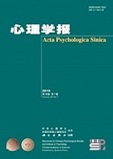|
|
Women’s Cue Preferences and Information Processing Mode in Mate Choice
LIU Yong-Fang,SU Li-Na,WANG Huai-Yong
2011, 43 (01):
21-29.
Among the wide range of theoretical and empirical findings on mate choice, the focus of much research has been on two important questions: What mate choice preferences do people have, and what is the information processing mode used in mate choice (Shackelford, Schmitt & Buss, 2005; Regan, Levin, Sprecher, Christopher, & Cate, 2000). However, most studies of these questions have been based on methods using personal advertisements, questionnaires, and interviews. Few researchers have used experiments methods to explore the preferences and information processing mode used in mate choice.
In this study, the information board technology was used to explore Chinese women’s cue preferences and information processing mode when they made mate choices under high or low time pressure, and with more or fewer candidates. The subjects were 68 young Chinese women from 20 to 33 years old. The selected eight cues appeared in the information board columns, and four or eight candidates appeared in the information board rows. This study used a 2×2 [low time pressure (60s)/ high time pressure (20s)]×[more candidates(8)/fewer candidates(4)] within-subject design. The recorded dependent variables were as follows: (1) the mean hit rate of each cue; (2) the mean processing time of each cue; (3) the mean decision time of finishing each information board; (4) depth of search, DS = the number of the opened cells / the total number of cells; (5) pattern of search, PS = (within options – within cues) / (within options + within cues), where “within options” refers to the number of movements from one cue to another in the same option, and “within cues” refers to the number of movements from one option to another on the same cue, and PS > 0 means that the decision-maker adopted a sophisticated search strategy based on options, while PS < 0 means that the decision-maker adopted a heuristic search strategy based on cues (Rieskamp & Hoffrage, 1999). In addition, subjects’ subjective rating of the importance of each cue and their satisfaction with the choices were recorded.
The results of the experiments showed that: (1) The candidate’s personality, state of health, and sense of responsibility were the top three cues that Chinese women consider; (2) Attribute preferences which were indirectly shown in completing the information board task were not equivalent to attribute preferences which were given directly in the subjective evaluation; (3) Mate choice used a heuristic searching process based on bounded rationality, and the number of candidates and time pressure affected individuals’ mode of information processing of mate cues; (4) There was not a simple linear relationship between the number of candidate and mate choice satisfaction—the increase in the number of candidates did not increase “satisfaction” of the mate choice.
These results concur with the hypothesis that human rationality is bounded (Simon, 1956; Kahneman, Slovic, & Tversky, 1982; Gigerenzer, Todd, & the ABC Research Group, 1999) and suggest that sophisticated decision tasks combined with little decision time will force people to use simpler information processing strategies (Payne, Bettman, & Johnson, 1993; Billings & Marcus, 1983; Timmermans, 1993). In some situations, the simpler rules can lead to better results (Goldstein & Gigerenzer, 1999).
Related Articles |
Metrics
|




